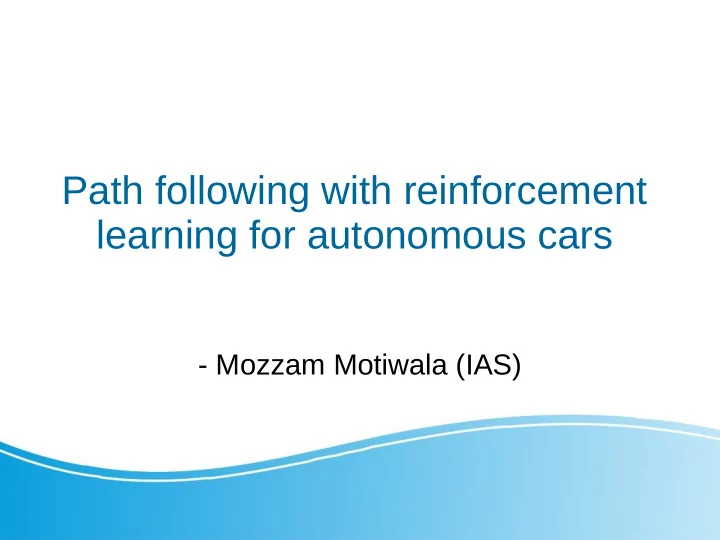

Path following with reinforcement learning for autonomous cars - Mozzam Motiwala (IAS)
Index ● Basics of Reinforcement Learning ● Model Based vs Model Free Reinforcement Learning ● Autonomous Car collision avoidance
What is Reinforcement Learning? ● Learning by trial and error only based on a reward signal[1] https://towardsdatascience.com/solving-the-multi-armed- bandit-problem-b72de40db97c Exploration vs Exploitation?
Markov-Desicion Process [1] Reward Function? Policy? Optimal Policy? Transition Function?
Some terminalogy ● Value Function: ● Action Value Function: Why Discounting Factor?
Gridworld [1]
Finding Optimal Policy [1]
Cart Pole Balancing Problem https://towardsdatascience.com/cartpole-introduction-to- reinforcement-learning-ed0eb5b58288 https://www.youtube.com/watch?v=Lt-KLtkDlh8
Index ● Basics of Reinforcement learning ● Model Based vs Model Free Reinforcement Learning ● Autonomous Car collision avoidance
Model-based By a model of the environment we mean anything that an agent can use to predict how the environment will respond to its actions[2]. https://towardsdatascience.com/model-based-reinforcement-learning-cb9e41ff1f0d
Example https://towardsdatascience.com/model-based-reinforcement-learning-cb9e41ff1f0d Whats Next? :: Now lets sample from it to adjust the policy..
Why model-based RL? Reduced number of Advantages? interaction with the real ● Fast environment while ● Need less data learning. Problems? Types: Neural Network Model, ● What if the model is wrong? Guassian Process Model.. etc
Model Based+ Model Free [2]
Results [1]
Why better result? [1]
Index ● Basics of Reinforcement learning ● Model Based vs Model Free Reinforcement Learning ● Autonomous Car Collision Avoidance
Application: Autonomous Car Why Reinforcement Learning? Problem with traditional methods ● Slow ● Assumptions Learning in RL ● Adapting to environment ● Learning from mistakes
Generalized Computation Graph Self-supervised Deep Reinforcement Learning with Generalized Computation Graphs(GCG) for Robot Navigation[3] [3] ● H=1 : Model-Free ● H= N (Length of Episode): Model-Based
Model Details ● Deep RNN as Model ● Model output 1= Current Reward ŷ: Robots speed ● Model output 2= Future Value to go(value of the state) ^b: Distance travelled before collision ● Policy Evaluation Function : ● Policy Evaluation by sampling k random action sequence and selecting the one with max reward.
GCG : Algorithm [3]
Evaluation and Results https://www.youtube.com/watch?v=NlFbLVG6LpA [3]
Summary ● Benefits of Reinforcement Learning ● Model-Free vs Model-Based ● Combined approach that subsumes Model-free and Model-based
References 1. R. Sutton and A. Barto, Reinforcement Learning: An Introduction 2. R. Sutton, “Dyna, an Integrated Architecture for Learning, Planning,and Reacting,” in AAAI, 1991. 3. G. Kahn, A. Villaflor, B. Ding, P. Abbeel, and S. Levine. Self- Supervised Deep ReinforcementLearning with Generalized Computation Graphs for Robot Navigation. InIEEE InternationalConference on Robotics and Automation, 2018.
Question?
Recommend
More recommend